As a guy who reviews new cars, I am often asked which cars are my favorite cars. Almost all of them are old cars – which could be nostalgia but maybe (I like to think) because they just had something new cars don’t.
Like this one, for instance.
This car was in my opinion the apogee of muscle cardom. It was also the last real muscle car, not only because it was built at a time when almost all other high-powered American cars had already disappeared but because it was the last really powerful American two-plus two coupe built without catalytic converters or significant emissions controls of any kind and no air bags, traction control, ABS or other electronic impedimenta. It was a raw and surly car that had little tolerance for inexperience or stupidity. Like all real muscle cars, it was more than a little dangerous.
Powerful cars have been built since then, including some with more than twice the power -but they are Safe Spaces compared with a car like the SD-455 Trans-Am. If you got the manual, you had to leg-press that heavy clutch without hydraulic assist. If you broke traction on the 1-2 upshift and didn’t know how to keep it straight, there was no TCS to bail you out.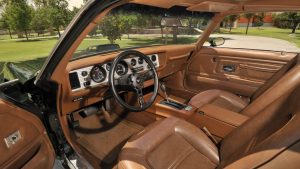
The brakes – discs up front, drums in the back and exactly the same as came on ordinary Firebirds with six cylinder engines or lightweight V8s like the 350 two-barrel – made you think ahead.
AC was available – but only with the optional automatic.
It was a serious car.
It was also the last real attempt by a major American car company – or at least, one of its divisions – to jam a thumb in Uncle’s eye. The SD-455 engine was not a run-of-the-mill 455 V8 engine. It was a very special engine. A race engine, detuned for production but largely hand built. It had a different block and heads and pretty much everything else that mattered – including provisions for dry sump oiling – but it had the same displacement as Pontiac’s mass-produced 455 V8, found in Bonnevilles and Catalinas. That one was “certified” by Uncle.
The SD-455 was not.
They slipped it into the mix, hoping Uncle would not notice. And for awhile, just long enough to get a few into circulation – he didn’t. About 1,296 of these very special engines made it into 1973 (and 1974) Trans-Ams and a handful of Formula Firebirds, which were the only Formula Firebirds built with the Trans-Am’s shaker hood scoop (but without the TA’s fender vents and front spoiler; you could get the rear spoiler as optional equipment).
The engine was initially rated at a very conservative 310 SAE net horsepower – which seemed wilty because just a few years prior, horsepower had been measured more optimistically, according to the SAE gross standard. The difference being the engine installed in the car, with a production exhaust and all accessories bolted to it – vs. engine on a test stand with open headers and no accessories.
The true output/capability of the SD-455 can be measured by the so-equipped Trans-Am’s quarter-mile times. On drag slicks (traction was the limiting factor, not horsepower) an otherwise stock SD-455 could clock a high 12 second quarter-mile. That performance stood for 16 years – until the ’89 15th Anniversary Trans-Am came along. It was powered by a transplanted Buick Regal GNX turbocharged V6, one of the most powerful engines made during the entire 1980s.
But the ’89 TA was automatic-only, punch it and go – while the ’73 TA could be ordered with a beefy four-speed manual that howled and whined like a 707’s turbojets spooling up on the take-off run, accompanied by the bellowing roar of the 850 CFM Quadrajet carburetor’s enormous secondaries opening. You could literally hear the atmosphere being gulped into abyss of the huge engine’s cylinders, a sound no modern, fuel-injected car makes – no matter how powerful.
Well, Uncle caught on – and the party was over almost before it started. Pontiac first had to swap cams – to a milder grind – to get the SD-455 engine “certified,” but only just barely. This engine was not going to fly with catalytic converters – which GM had to install in all of its 1975 models, to get them “certified” by the EPA.
It was the death knell for the SD-455 and for muscle cars, at least as they once were.
There are faster cars now, but they lack that special something that defined the originals. The SD-455 leapt the fence – an Indian off the reservation, tomahawk in hand and hungry for some scalps.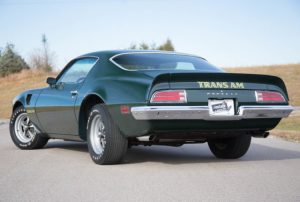
I prefer the ’73 over the ’74 because the ’73 retains the beautiful bodywork of the 1970 Trans-Am, which was designed before Uncle got in the business of designing cars. The ’74 is marred by ugly (vs. the ’70-’73) “federal” 5 MPH bumpers, which amount to putting braces on Scarlett Johansen.
The ’73 cars also – reportedly, some of them – got the SD-455 with the hotter cam, before Uncle descended.
Make mine Brewster Green, with the Hurst-shifted four-speed and the Honeycombs.
. . .
Got a question about cars – or anything else? Click on the “ask Eric” link and send ’em in!
If you like what you’ve found here please consider supporting EPautos.
We depend on you to keep the wheels turning!
Our donate button is here.
If you prefer not to use PayPal, our mailing address is:
EPautos
721 Hummingbird Lane SE
Copper Hill, VA 24079
PS: Get an EPautos magnet (pictured below) in return for a $20 or more one-time donation or a $5 or more monthly recurring donation. (Please be sure to tell us you want a sticker – and also, provide an address, so we know where to mail the thing!)
My latest eBook is also available for your favorite price – free! Click here. 


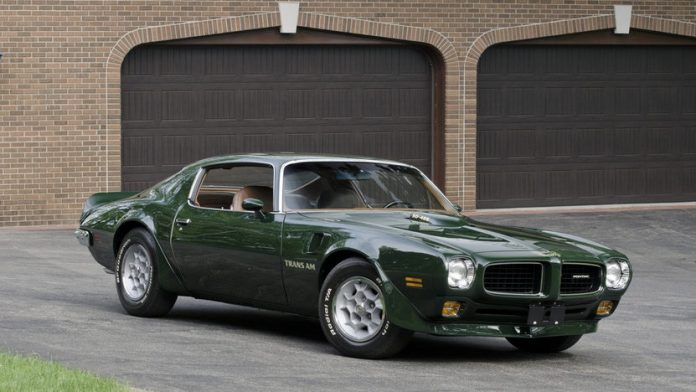

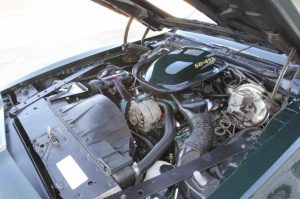







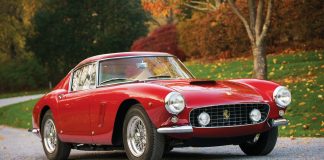
The SD 455 was not a race engine.
And it was not conservatively rated at 310 either. In fact, it was accurately rated at 290. Net, of course.
I was in High School in the early 1980’s. One of my good friends had a 1973 SD 455 TA. It was indeed a very special engine and drivetrain. When we would drag race on weekends, there was only one car that could beat him. That was a 1969 supercharged Camaro. That Camaro had been modified to the hilt. The Trans Am had no modifications, other than the keg in the trunk with the supply line run under the carpet up into the middle console. Can’t imagine doing something like that today. Good times, good memories.
Thanks, LTD!
I make do with my ’76 – same basic car – and its 455, though not an SD, now makes more than SD power!
I’m no ‘Bird/T-A fan…but DAYUUUMMMM that is one gorgeous car- and with the 4-speed….I can’t imagine anything being much better!
Gorgeous – luv it.
I ordered a 1974 SD 455 with a 4 speed and had to wait 10 months. They were the last ones made after the automatics. About 212 were made id I remember right. Put 2″ Hooker headers on it, Deepened the oil pan, lowered it and put magnesium menilites on it. Ran the car in local solo1 and solo 2 events for number of years. It would chirp the tires at 55 mph. The good old days …
I’m envious, Anonymous!
I’ve had to make due with my ’76… but it is Carousel Red, at least – and it does have a 455 and Honeycombs!
Eric: When my high school buddy got back from Vietnam he bought a used C3 Vette, then he swapped that in for a new ’72 TransAm, 455, auto, bright red, with the shaker hood (shaker air cleaner actually, as I recall).
I never drove it, but we used to rip it around real curvy roads and he said it handled better than the Vette did. It had real tall gears, also as I recall. At 120 it was still in 3rd? — don’t remember for sure, but it was a nice car!
Hi Bruce,
Yup!
It’s not well-known, but the ’70s Trans-Am was the best-handling American car. Better-handling than the same-era Corvette which did not handle well. The apogee of Trans-Am handling was the ’78-’81 TA with the WS6 suspension package, which included aluminum 15×8 wheels, four-wheel-disc brakes and different steering box, along with larger diameter anti-sway bars. These cars cornered as flat as the deck of an aircraft carrier and – with modern tires – feel astoundingly modern, even nearly 40 years later.
I wonder if the SD 455 was indeed available in Bonnevilles and Catalinas as a special order item. If so, you’d have one helluva sleeper!
Bryce, COPO was one of the greatest things to happen to autos in the 60s and even 70s. Whatever GM had in an entire line of cars was available by using the COPO from to order a car.
No telling how many completely unique cars were made with this form. I knew a farmer who checked the right boxes and got a one of a kind 69 Chevy pickup with a rare type of 402 BBC and that thing was the true sleeper. Bad to the bone performance from a normal looking pickup.
You wouldn’t think twice about a red half ton pickup except it would leave a 440 high performance Fury with the police package in the dust.
Oh wait, that couldn’t be true……if you believe anything Scotty Kilmer says. He doesn’t mention the SBC in the all time best V8’s.
COPO is a Chevy thing for fleet orders. It was not a facade for an entire line. If anything, it was a shroud to allow 427 cars when faced with a cid edict.
Hi Bryce,
Pontiac had planned to offer it in the GTO – there was even a prototype – but it got quashed, along with the whole SD program and (soon thereafter) the GTO itself.
I would never want to live somewhere that I couldn’t register or drive whatever I wanted.
Fortunately it isn’t a problem where I can carry whatever kind of firearm I want, open or concealed, without getting more than a couple of glaces from the local LEOs. The first is to see if it is serious enough to be dangerous. If it is, the second is to get a good enough look at me to be able to find me if the sheriff is forming a posse.
If any of this sounds unlikely in your locale, maybe it is time to move back to America.
Wyoming? Most of these untied states don’t qualify. Just curious.
Wyoming was my choice before New Hampshire got the nod from the Free State Project, and they have yet to have half of their commitments fulfilled.
14 states have adopted red flag laws, which would preclude their rationality remaining.
My county has 14 registered firearms per capita, subject to what routinely happens at gun shows and yard sales. One of the three school districts in the county have repealed its gun free zones in favor of arming those school employees who will comply with a training and qualification program more stringent than most police departments require.
This was accomplished by the concentrated effort of a former school board member who boasted about being armed at all times, and especially on district property.
“Pontiac first had to swap cams – to a milder grind – to get the SD-455 engine “certified,” but only just barely.”
And then, I assume, quite a few of those owners swapped out the camshaft to a higher performance grind again.
Hi Jim,
Yup!
And that was one of the many beauties about these cars – and the cars of that era. My ’76 also came with a weak cam, low compression and so on. Which is why the 455 only made 200 hp that year. But a $300 cam kit, headers and some tuning could easily bump the output of the otherwise stock engine to 300 horsepower or more. Some head work and bump the CR up two points and now you’re making serious power… and it could all by done affordable, with hand tools, by anyone reasonably competent with machinery…
We watched American Beauty recently. I love the scene where Kevin Spacey’s wife comes home and asked whose car that is in the driveway. She was incensed Kevin had traded a Camry for a pristine 1970 Firebird, the car he always wanted but never had. It’s a damn funny scene since he’s lifting weights and smoking pot, two more things she highly disapprove of.
Yep, great scene- great car.
I graduated from high school in 1973. Enough said! Great article!
I never made it to graduation ceremonies. I settled for a signed letter from the principal saying that I had completed the requirements to graduate and would receive a diploma after they were printed in the spring.
I started working for Western Electric a week later, when I was 17, for $800 a month, in 1972.
I miss those TA too, I liked the Firebird emblem that was on the hood, like the Phoenix of the X-men. Those were the cars to own. Now all the cars look alike – Accord, Camry, Teana/Sentra, M. Benz’s they all have the same style on them. There is no originality anymore.
Hi Hugh,
Cars dont sell on originality or that kind of look anymore. Infact most people who are genuine car people hardly go and buy a new car anymore. Actually nobody “buys” a new car anymore – they lease or finance them. And then use them till the lease runs out at which point they lease or finance another one. They all look the same because they are basically meant to appeal to the sort of person who goes and leases these things (or has their wife nag them into it) for a couple years at which point they get another one…. and when they do decide if they should lease one over the other, the deciding factor isnt say the look of the car, its how many bells and whistles (like car play, cameras) it has rather than how it looks or power…. and then what the monthly payment is…. nothing else really…. As they dont actually ever own the care or have it longer than a couple years, they hardly care to build that sort of bond with the car its just a tool, the metal may well have been made into a washing machine or something……
Hi Nasir,
This is the best summary of the dilemma – for people like you and I – that I’ve read so far.
Cars used to be about passion or at least, emotion. Now they’re just what you’ve described – interchangeable, disposable appliances you use for awhile and then toss, just like a washing machine.
This happened for a number of synergistic reasons, among them the gradual (and now omnipresent) intrusion of the government into vehicle design, the now dominant influence of women (who birthed the Safety Cult) as well as the increase in traffic and extreme traffic enforcement (including mandatory insurance) which has taken much of the fun out of driving and turned it into an expensive burden. Or – and this is worse – something boring.
The love affair so many had with their cars has become like a bad marriage on the verge of divorce.
–Wow, I’m channeling Tor this morning! Hope it doesn’t become a trend.–
We now need a car, instead of wanting a car.
The result of spreading out and zoning out the American city, sold to us under an odd manipulation of the Jefferson ideal of landowning citizenry. The idea was we’d own a piece of the woods to do with what we wished. Back in TJ’s time it was possible to run a small business on a piece of property, perhaps providing processing services for your neighbors who might sell you the raw materials for you to add your labor. But that wasn’t “efficient” (another falsehood) or pretty, and the central planners decided that single use structures, properly zoned, were the best way to construct cities. It was only about 100 years ago one could still see homes next to office and light industrial spaces in cities, and of course there’s the neighborhood intersections with the bar on one corner, the church on the other. When I was a child our dentist’s and family doctor’s practices were run out of the front of their homes, and that was in the 1970s. With the rise of the suburbs the corner bar became the restaurant in the strip mall. What was the only way to get there? Take the car. Time to go to the market? Well, that’s several miles away, so better get the wife one too. And it’s such a pain to shop, better stock up. But that means no fresh vegetables, so science adds some petrochemical freshness. As for the church, well that’s become a stadium-sized multimedia extravaganza, so far removed from daily life as to make it completely irrelevant to anyone.
I’ve lived in neighborhoods built pre-car as well as neighborhoods built post-car. They both have their advantages and disadvantages, but for sure owning a car was less of a burden and more of a pleasure in the pre-car neighborhood. I didn’t feel like I had to drive. I suspect that I was able to keep the vehicle for an extra 3-4 years past its planned obsolescence date just because it sat in the driveway for days at a time. When it was time to buy new I was able to put down a significant down payment and actually custom order the vehicle I wanted because I wasn’t over a barrel. When I lived in the pre-car neighborhood I was a bit of a regular at the local bar, at least on payday, because I could stumble home at the end of the night instead of fearing a shakedown (or worse) from an AGW. In general there was activity nearby all the time, since businesses and residences were close together. It felt more like a community. Of course there were still lots of vehicles around, everyone had one, but most of them were older and in the case of trucks were highly customized.
Now that I live in a post-car neighborhood it feels very “Night of the Living Dead.” Every day we all leave our neighborhood, moving swiftly through the expertly designed streets, watching for AGWs looking for excessive speeders on roads made to move vehicles quickly, not deliver customers to businesses. I often work at night, and if I go about my business during the daylight the streets are barren and it sometimes feels like the rapture might have taken place (of course on Sunday afternoon that feeling is far worse except when it is warm you’ll sometimes hear a cheer or two from an open window). We all live in a clockwork world, activity timed to the minute. The local watering hole has become the meet market out by the big box store, with goals and scores and codes to be interpreted. Or worse, the entertainment center, this time with a different goal of distracting with overstimulation of the senses, not getting to know anyone outside of your existing circle. Either way they’re set up to create an event, not a clientele.
And we need cars, reliable cars, with lots of space and power. And when it dies we need another, right now. So instead of ordering what we want we take what we can get. Since they all look alike anyway who really cares? You can have the blonde one or the brunette one, but I’m afraid the redhead is a little out of your budget. That’s OK though because in a few years it will be fat and surly anyway.
We live way the hell out in the hills so we absolutely NEED some sort of vehicle (often a 4×4) to get to town once in a while, plus a spare vehicle and a second spare vehicle. But right now they are all old and paid for and more or less repairable if needed (usually something needed at any given time).
But years ago there was a railroad running along the river a few miles down the crick. Our neighbor’s late dad told us about how they used to take a wagonload of wheat down to the little village at the train station to sell, and then buy the supplies that they couldn’t grow or make or do without. Or – you could buy a ticket and go anywhere in the USA.
In my part of the country, when the going gets serious, the serious get on a horse, or a snowmobile.
Hi Hugh,
And even the base Firebird was essentially the same thing – same basic body and layout, with the mechanicals easily upgradeable by anyone so inclined – for half the price.
That’s another thing we’ve lost.
There are economy cars and there are performance cars but there are no performance cars that are sold in an economy car version. Put another way, the bar to entry has been raised – and it’s one of the reasons why car culture is on life support. Back in the day, a high school kid could easily afford a used Firebird or Camaro; maybe not a Trans-Am or Z28, but all the essentials were there. All of the parts that made a Trans-Am or Z28 what it was could be bought used/scrounged at junkyards and bolted to the car you had. The base cars with the six were all set up to receive the V8; they bolted right in. Everything was easily interchangeable and (generally) cheap. No complicated/expensive modifications to the car you were working on were necessary. You didn’t need to find compatible computers and body control modules. Just bolt it on – and go!
Before the early-mid 1970s six cylinder cars almost always required a lot of upgrades to be a V8 car. Yes you could put a V8 in a six car and then live with a suspension, drive line, brakes, and more that wasn’t up to the task. Six cylinder base cars often got 4 lug wheels while V8s got 5 because everything was different. Sure it could all be swapped out from a donor car, but remains a lot of work.
My Maverick is one of the exceptions. Ford 250cid I6 cars got V8 components. But these are exceptions to the old time rules. Now by the late 1970s the differences between 6 and 8 dwindled considerably. ’75ish on. The cars became more standardized.
Hi Brent,
With ’70s Camaros and Firebirds, the main difference was the coil/leaf springs. The brakes were pretty much identical from base to Z28/Trans-Am (excepting the ’77-81 TA, which offered four wheel discs) and the wheels were not much different – 14s vs. 15s. The frames were identical.
And if you started with a car that had a base V8 (e.g., an Esprit Firebird with a 350 2 BBL) you got parts that were very close to what the top-of-the-line models had.
The cool thing was it was all bolt-on stuff. No got-damned computer compatibility issues. If it physically fit, it worked!
6=8 http://www.cliffordperformance.net
known about them for 30 years. I have an aftermarket cylinder head for my 250 that I’ll install someday. Maybe I should just quit working so I have time for my projects.
Yep, my brother and I dropped a 360 and Auto into a 73 Dodge van that had a top speed of 60 with the slant 6. Got 5 more mpg, an extra 50 mph top speed, a lot more torque and a lot more fun vehicle to drive. Even got it to 100 mph once with the 360. Took 3 tries to get the right oil pan for the motor but we got there.
I got my ’75 Dodge Dart Sport slant 6 up to 95 mph on a deserted stretch of highway. I was a 16 year old kid and I lead-footed the hell out of that engine and it never failed me. That thing was bulletproof.
Such, such were the days. My dad picked me up after school one day in a new ’70 or ’71 Cuda 340 he was “test-driving,” knowing that he was going to buy a Plymouth station wagon anyway. We went for a fun ride on the city’s back roads, broadsliding and breaking all kinds of traffic laws. We won’t see those days again.
Hi Ross,
I took my ’76 out yesterday; last week’s snow had melted and we had a good rain afterward, which washed away the road salt.
My car’s not an SD car, of course. But one of the wonderful things about cars of that era is that it was easy to upgrade.
The government hadn’t yet destroyed the foundations. By ’76, the 455 was down to 7.6:1 compression, a mild hydraulic cam and 200 net horsepower. But it was still a 455. And the TA was still RWD and all the good parts bolted right up. The owner could countermand the government in a weekend of wrench turning.
All gone now.
No Screamin’ Chicken on the hood??
No Way that can be the Apex Firebird! 😉
Hi Mike,
1973 was the first year for the big hood bird decal, too! But many people don’t know it wasn’t standard. IIRC it was a $50 option. Almost everyone ordered (or bought) their car this way, though!
I miss my old cars, now your gonna make me cry, dammit!
gtc, I know how you feel. My 67 Malibu Sport was such a nice, smooth, good handling and very quiet car. Simple, clean lines and body by Fisher. A 275 hp 327 that could be turned into 425 hp and use all GM psrts. The slick close ratio 4 speed and just the nice interior extremely beer resistant and always looked like new with nothing but Pledge furniture polish.
Du Pont had a new formula wax that made the exterior bling. A full-size interior and trunk inside and a back seat made just for grandma’s handmade quilt that matched the interior and made your best girl feel right at home. The trunk readily accommodated a pony keg and No. 3
wash tub. The wonderful times had in that car couldn’t be repeated in a new car and wouldn’t come close to being the same in an Suv or crossover.
Even Merlin my Persian tomcat loved to ride on the top of the bucket seats and look inscrutable for other travelers. I’d have to say he added a unique touch……RIP Merlin the dog tamer..
Didn’t know Pontiac tried to ‘hide’ that engine, and didn’t know ‘that’ engine existed at all. Ahhh, the good old days when the private sector actually fought regulation and with action. Thx.